A number of Bristol’s cultural and historical threads intertwine at its central harbour where a selection of buoyant attractions make tangible this city’s engaging past as well as its exciting present.
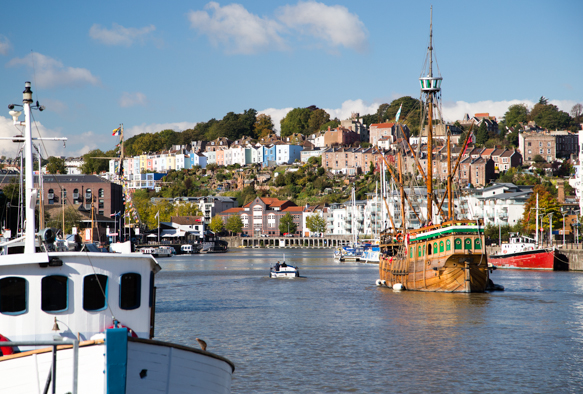
The Matthew sails through Bristol Harbour. (Photo: Chris Allsop)
The south west city of Bristol has a long, chequered, and colourful maritime heritage. Out of the gently winding Avon River, the explorer John Cabot became the first European since the Vikings to land in North America; the 18th century saw the city become fat on the proceeds of the slave trade; while Bristol’s dockside pubs inspired writers like Robert Louis Stevenson and Daniel Defoe.
However, the city’s livid rusted heart has to be the restored SS Great Britain, the world’s first ocean liner and now a popular multi-part historical attraction (£14 per adult). Preserved in the original dry dock from which she was launched in 1843, the steamship is where the city’s glorious industrial history intersects with the sea. Designed by Isambard Kingdom Brunel, the engineer behind the Bristol Suspension Bridge (and close second to Abraham Lincoln for Best Wearing of a Top Hat by an Historical Figure), the ‘Grand Old Lady’ was the first iron steamer to cross the Atlantic.
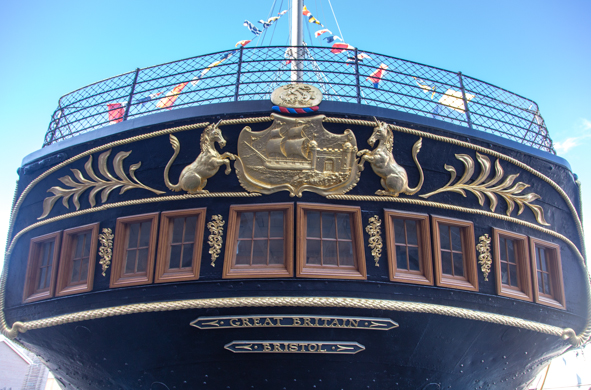
The ornamented stern of the SS Great Britain (Photo: Chris Allsop)
After an impressive 88 years of service, covering enough ocean to sail around the world 32 times, the creaking SS Great Britain was abandoned in the Falkland Islands. A large crack remains on its starboard side where it rested against the sea floor in Sparrow Cove, but otherwise the ship has been restored to its 19th Century heyday when it was the hottest transportation ticket in the world.
Descending into the dry dock, you immediately hear the insistent thrum of the immense dehumidifier arresting the red-painted hull’s decay by reducing the level of humidity to equal that of the Arizona desert. It’s an extremely atmospheric experience: With the light refracting through the 10 centimetre false “sea” above, it feels as if you’re underwater hearing the pulse of the vast propeller driving the ship through the Atlantic swell.
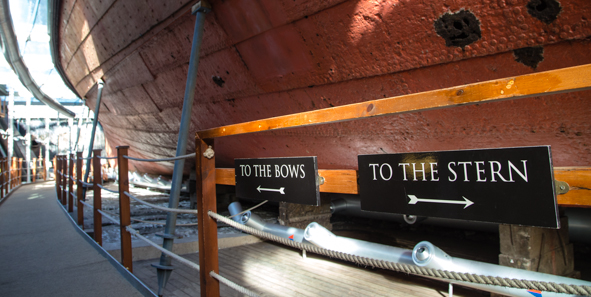
The SS Great Britain’s bulging hull secured in its climate-controlled dry dock. (Photo: Chris Allsop)
Inside the museum, there’s documentary footage of the near wreck being towed home from the Falklands in 1970, as well as interactive shenanigans such as a steering wheel with internal workings exposed. Once you’ve drunk deep of rivets, rust and revelations, you board the ship at the weather deck. Pick up an audio guide and listen to the hilarious diary accounts from past passengers as you proceed below, breathing in the smell of wood polish, to experience life on the promenade and saloon decks, and perhaps thinking of Ryanair and modern ferry travel and, in a quiet corner, shedding a small tear.
A new ‘Go Aloft’ experience is now available (extra £10 on top of your ticket price), offering you the opportunity to scale the main mast’s rigging. Mooted for 2017 is an extension of the site, with the conversion of Brunel’s old offices into a new museum allowing you to nosy in on the great man’s mocked-up study.
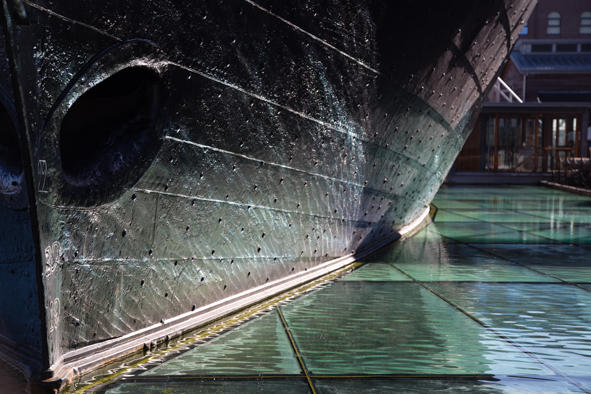
The SS Great Britain in its 10 centimetre sea covering over glass. (Photo: Chris Allsop)
If exploring the Grand Old Lady ignites a desire to hit the high seas in archaic fashion, look up The Matthew – a replica of the ship that explorer (and secret Italian) John Cabot sailed westwards in 1497. This stunning replica, moored alongside the M Shed museum on Princes Wharf, offers a variety of trips Tuesday to Sunday, such as its gentle 45-minute harbour tour (£10 for adults).
But the city’s heritage at the docks isn’t solely represented by long dead explorers and industrial age leviathans. The Thekla nightclub, a former cargo ship, has, since the 90s, been an anchor of the local nightlife scene (prior to that it had an intriguing history as an avant garde floating theatre). Moored in the Mud Dock area, the ship made its name as an epicentre of the city’s pioneering Drum & Bass scene. Hosting regular club nights as well as one-off gigs, the Thekla showcased local legends such as Massive Attack, Roni Size, and Portishead in the intense, frequently marijuana-fogged hold. Since then the stage has featured an eclectic array of artists including big names like Florence & The Machine or Crystal Castles, and less well known cult artists such as Brighton-based DJ and producer, LuQas.
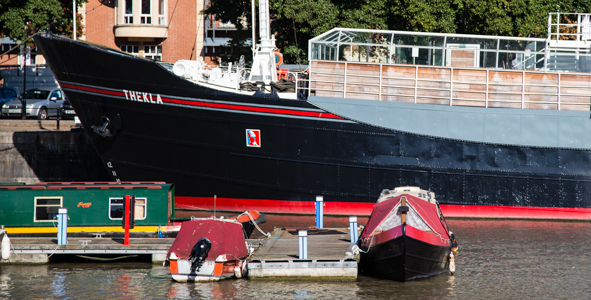
The Thekla’s hull is used as an invitation-only exhibition space for local street artists (Photo: Chris Allsop)
When the boat was renovated in 2014, the management were forced to remove a deteriorating Banksy stencil, showing Death in a rowing boat, from the hull. The artwork is now on loan to the M Shed where it’s again on public view. In keeping with the precedent established by Bristol’s most famous street artist, the exterior of the ship is now used as an invitation-only exhibition space for the city’s best street artists, with new works being added on a regular basis.
Whether you decide to sing shanties at the Thekla or scale the SS Great Britain, sustenance will be required. Keep it nautical and pop over to the Glassboat restaurant. Moored near Bristol Bridge since 1986, the Glassboat is a renovated hundred year-old barge that used to haul timber up the Bristol Channel. Now all pristine glass and walnut floors, dinner there is something of an event and the prices reflect that (a dinner main of cannon of lamb, ratatouille, and olive jus is £20). However, lunchtime favours the brave as there’s an enticing three-course menu on offer for a bargain £12. Enjoy – just don’t go overboard.